TBR Pile vs. Time: The Case That Never Gets Closed | A Cozy Courtroom Confession for Every Book Loverl (From the “Trials of a Reader’s Mind” series)
Fiction Accused of Manipulating Reality: Nonfiction Takes the Stand
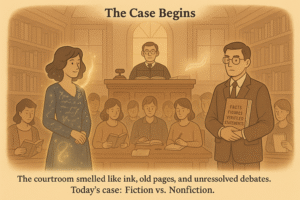
A dramatic cross-examination of storytelling and truth
The courtroom smelled like ink, old pages, and unresolved debates.
Today’s case: Fiction vs. Nonfiction.
The charge? “Manipulating reality.”
The audience was full of readers — some holding novels like comfort blankets, others with notepads full of citations.
At the center stood two opposites: Fiction, smiling faintly, and Nonfiction, adjusting their spectacles with purpose.
Opening Scene: The Accused Arrives
Fiction walked in like a character written by itself – poker-faced, unreadable, every movement deliberate.
Its outfit was stitched with metaphors, and it radiated the kind of charm that could make even the jury doubt the truth.
Nonfiction followed, neat and polished, holding a stack of neatly labeled files titled “Facts, Figures, and Verified Statements.”
They were the embodiment of credibility, walking discipline with corrective glasses.
The contrast was sharp.
One made people feel.
The other made people think.
The Defense: Fiction Speaks
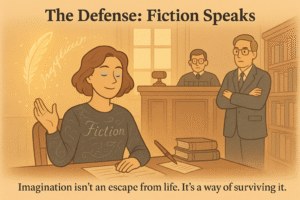
When Fiction took the stand, the courtroom leaned forward.
“Don’t we already know reality enough?” it began.
“Haven’t we lived it, felt it, and suffered through it? Isn’t it fair to take a break?”
A murmur spread through the crowd.
“Imagination,” Fiction continued, “isn’t an escape from life. It’s a way of surviving it.
We give people a pause from thoughts that eat them alive.
You call it make-believe. I call it breathing room.”
The defense rested, not with evidence, but with emotion.
The Counterargument: Nonfiction Responds
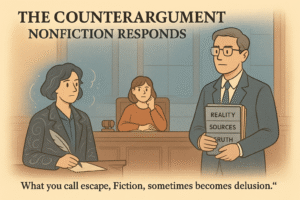
Nonfiction stood tall, voice measured but sharp.
“What you call escape, Fiction, sometimes becomes delusion.
You create alternate realities so convincing that people forget they’re not real.
You make them believe every love story will be cinematic and every tragedy poetic.”
Nonfiction’s gaze softened, though.
“I don’t hate you,” it said quietly.
“I just want people to know the difference between the story and the source.”
The Judge’s Verdict
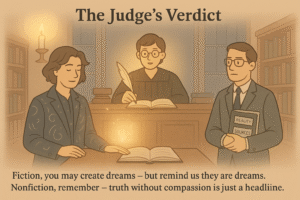
The Judge sighed, clearly torn between the two.
“Reality can be tiring,” they began, “and Fiction offers hope, that is true.
But readers deserve a disclaimer: this is imagination, not instruction.”
The courtroom nodded.
“Fiction,” the Judge said, “you may continue to create dreams, but make sure they come with a reminder that they are dreams.
And Nonfiction, remember — truth without compassion is just a headline.”
Gavel down. Verdict delivered.
The Exit Scene: Mutual Realization
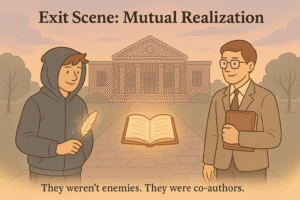
As everyone left, Fiction turned to Nonfiction and smirked.
“Tell me something,” it said. “When you came in today, didn’t you imagine winning this case?”
Nonfiction blinked, then admitted, “Yes.”
Fiction tilted its head.
“Wasn’t that… a fictional reality you created?”
Nonfiction smiled, walked toward the car, then called back,
“For this trial, didn’t you prepare evidence, statements, and logical reasoning?”
Fiction nodded.
“Then congratulations,” Nonfiction said softly. “You finally used facts.”
Both smiled and went their separate ways.
Because even in a courtroom of opposites, truth and imagination knew one thing:
They weren’t enemies. They were co-authors.
This post is a part of Blogchatter Half Marathon 2025
